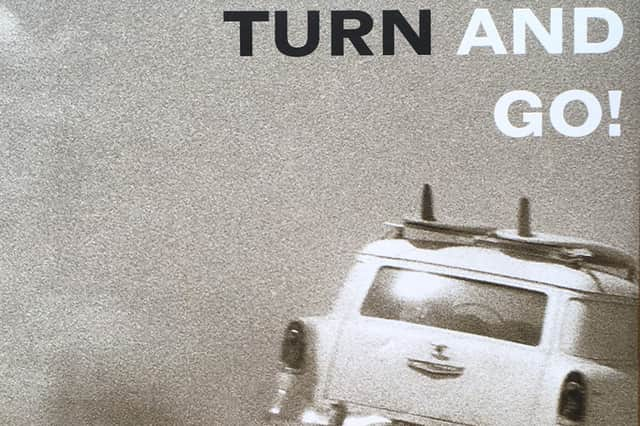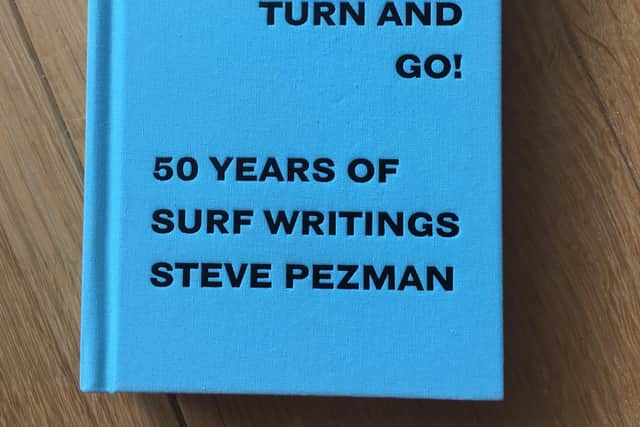Book review: Turn and Go! 50 Years of Surf Writings, by Steve Pezman


Surf journalism bears very little resemblance to conventional sports journalism. At least, that's always been the case in the world's major surfing publications in the 30-odd years since I first started reading them. Have I always been aware of this difference? Perhaps. I'm not going to pretend to be able to inhabit my early-teenage brain from the vantage point of my 40s. However, after spending my football-mad years of 8-12 consuming a steady diet of match reports in my dad's discarded newspapers, I must surely have been aware that something very different was going on when, aged 12 or 13, I picked up my first few copies of US mag Surfer and and its UK equivalent, Wavelength.
None of which is to say that the best football writers don't occasionally transcend the strictures of straight-up reporting and touch on deeper truths. It's just that, in most conventional sports, winning and losing is at the heart of the story; the facts of a game matter. In surfing, by contrast, such concerns are peripheral at best. Even in the rarefied world of competitive surfing – which has little bearing on the lives of the wave-sliding majority – it's not really the winning that counts, but how you win. Witness, for example, the outpouring of bile directed at Australia's efficient, businesslike, small-wave maestro Damien Hardman when he won his second world title in 1991. “It’s stupid that he’s world champion and he can’t paddle out when it’s over six-foot”, opined free-thinking aerial ninja Christian Fletcher. Most of surfing’s icons – from Miki Dora to Gerry Lopez to Dane Reynolds to Kai Lenny – have never won a world title.
Advertisement
Hide AdAdvertisement
Hide AdWhy is surf journalism different? You could argue that the sport of surfing itself – if you can even call it a sport – inherently lends itself to an oblique journalistic treatment. The apparently simple act of "going surfing" requires travel, engagement with the elements and a quest for something that may or not be there, and it culminates in an aesthetic though entirely pointless act that leaves no trace. In order to reflect all this, surely surf writing must necessarily be a blend of travel writing, nature writing and art criticism, also incorporating a soupcon of "what's it all for anyway?" existential angst. But must it? In his forward to a new book of writing by veteran surf journalist Steve Pezman, titled Turn and Go!, Pezman's former colleague at The Surfer's Journal Scott Hulet argues that the eventual shape of surf journalism was never a foregone conclusion.


In the 1950s, he points out, surfing "was viewed as a teenage dance craze, its Cherry-Coke-addled, hormonal participants doing the Frug to the reverb-tanked twerp pop of Jan and Dean". As a result, he suggests, "surfing could have gone hopelessly pop. Contests, gossip, hullabaloo." That it didn't, according to Hulet, is in no small part down to the sensibilities of Pezman and other trailblazing surf journos of his generation.
"Pezman," Hulet writes, "chose a different route" – and his choice mattered, because in 1968 he was hired as editor of Surfer magazine, the California-based "Bible of the sport", and within six months was promoted to publisher. Then, in 1992, he launched The Surfer's Journal, which continues to flourish as a print magazine, at a time when other publications (including Surfer) have been felled by the internet.
"Surf publishing's tradition of idiosyncratic, esoteric, cosmic-tinged reportage was at high whine during the 1970s,” writes Hulet, “and Pezman embraced all of that."
And how. Turn and Go! is a pure hit of surf writing at its most creative, open-minded, and gloriously gonzo. Witness, for example, "The Curren Gun Project", first published in The Surfer's Journal in 1994. Reminiscing about riding big waves in Hawaii in the early 1960s, Pezman remembers going halfers on Pat Curren board with his friend Bob Beadle. "A full-on 11'4" rhino chaser... with a very narrow, extreme plan shape… the thing looked scary just sitting there on the floor." The board, he says, was the source of a number of memorable moments, but it wasn't long before he traded it in for something else. "My mistake," he realises, but rather than leaving it at that, he contacts Curren – by this stage well into his retirement down in Mexico – and asks if he'd consider shaping another one; then spends the best part of a year ordering balsa wood of the right size and quality from somewhere in Ecuador. In the end Curren built six of his “sensual, sculpted shapes.”
Elsewhere, Pezman talks surf psychology with Dr Timothy Leary, engineers a meeting between 60s big wave legend Greg Noll and 90s big wave legend Brock Little, and reflects on the many ways in which California surfers used to defy the US Marine Corps in order to surf the off-limits waves at Lower Trestles during the 1960s and 70s. “Imagine where [surf journalism] could have gone if it had landed other, more booster-ish stewardship,” muses Hulet. Thanks goodness for Pezman.
Turn and Go!, by Steve Pezman is available from www.surfersjournal.com
